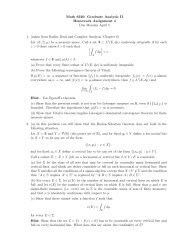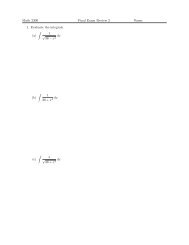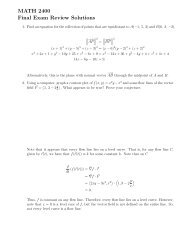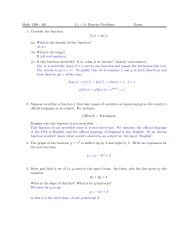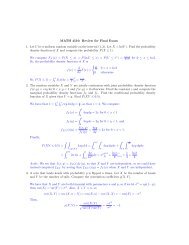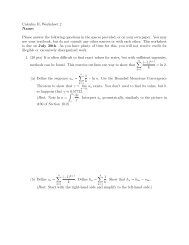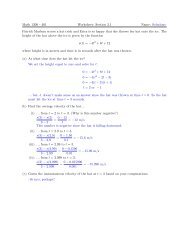Partition Algebras
Partition Algebras
Partition Algebras
Create successful ePaper yourself
Turn your PDF publications into a flip-book with our unique Google optimized e-Paper software.
<strong>Partition</strong> Algebra A k and S n Representations of S n<strong>Partition</strong> <strong>Algebras</strong>Erica ShannonApril 10, 2012
<strong>Partition</strong> Algebra A k and S n Representations of S nElements of the <strong>Partition</strong> MonoidLet k be a positive integer.DefinitionA k = {set partitions of {1, 2, . . . , k, 1 ′ , 2 ′ , . . . , k ′ }}.
<strong>Partition</strong> Algebra A k and S n Representations of S nElements of the <strong>Partition</strong> MonoidLet k be a positive integer.DefinitionA k = {set partitions of {1, 2, . . . , k, 1 ′ , 2 ′ , . . . , k ′ }}.ExampleSome elements of A 4 are• {{1, 2, 3, 4, 1 ′ , 2 ′ , 3 ′ , 4 ′ }}• {{1, 2, 3, 4}, {1 ′ , 2 ′ , 3 ′ , 4 ′ }}• {{1, 2, 1 ′ , 2 ′ }, {3}, {4}, {3 ′ }, {4 ′ }}• {{1 ′ }, {1, 2, 2 ′ , 3 ′ }, {3, 4, 4 ′ }}
<strong>Partition</strong> Algebra A k and S n Representations of S nElements of the <strong>Partition</strong> MonoidLet k be a positive integer.DefinitionA k = {set partitions of {1, 2, . . . , k, 1 ′ , 2 ′ , . . . , k ′ }}.ExampleSome elements of A 4 are• {{1, 2, 3, 4, 1 ′ , 2 ′ , 3 ′ , 4 ′ }}• {{1, 2, 3, 4}, {1 ′ , 2 ′ , 3 ′ , 4 ′ }}• {{1, 2, 1 ′ , 2 ′ }, {3}, {4}, {3 ′ }, {4 ′ }}• {{1 ′ }, {1, 2, 2 ′ , 3 ′ }, {3, 4, 4 ′ }}We refer to each individual subset of {1, 2, . . . , k, 1 ′ , 2 ′ , . . . , k ′ } asa block.
<strong>Partition</strong> Algebra A k and S n Representations of S nGraphsWe represent a set partition d ∈ A k by a graph.
<strong>Partition</strong> Algebra A k and S n Representations of S nGraphsWe represent a set partition d ∈ A k by a graph.Example{{1 ′ }, {1, 2, 2 ′ , 3 ′ }, {3, 4, 4 ′ }} corresponds to the graph1 2 3 4✉ ✉ ✉ ✉❅❅✉ ✉ ❅✉ ✉1’ 2’ 3’ 4’
<strong>Partition</strong> Algebra A k and S n Representations of S nGraphsWe represent a set partition d ∈ A k by a graph.Example{{1 ′ }, {1, 2, 2 ′ , 3 ′ }, {3, 4, 4 ′ }} corresponds to the graph1 2 3 4✉ ✉ ✉ ✉❅❅✉ ✉ ❅✉ ✉1’ 2’ 3’ 4’The graph is only defined up to its connected components.
<strong>Partition</strong> Algebra A k and S n Representations of S nGraphsWe represent a set partition d ∈ A k by a graph.Example{{1 ′ }, {1, 2, 2 ′ , 3 ′ }, {3, 4, 4 ′ }} corresponds to the graph1 2 3 4✉ ✉ ✉ ✉❅ ❅❅ ❅✉ ✉ ❅✉ ❅✉1’ 2’ 3’ 4’The graph is only defined up to its connected components.
<strong>Partition</strong> Algebra A k and S n Representations of S nGraphsWe represent a set partition d ∈ A k by a graph.Example{{1 ′ }, {1, 2, 2 ′ , 3 ′ }, {3, 4, 4 ′ }} corresponds to the graph1 2 3 4✉ ✉ ✉ ✉❅ ❅❅ ❅✉ ✉ ❅✉ ❅✉1’ 2’ 3’ 4’The graph is only defined up to its connected components.
<strong>Partition</strong> Algebra A k and S n Representations of S nGraphsWe represent a set partition d ∈ A k by a graph.Example{{1 ′ }, {1, 2, 2 ′ , 3 ′ }, {3, 4, 4 ′ }} corresponds to the graph1 2 3 4✉ ✉ ✉ ✉❅❅✉ ✉ ✉ ❅✉1’ 2’ 3’ 4’The graph is only defined up to its connected components.
<strong>Partition</strong> Algebra A k and S n Representations of S nComposition in A kWe define a composition operation on elements of A k .d 1 = {{1 ′ }, {1, 2, 2 ′ , 3 ′ }, {3, 4, 4 ′ }}d 2 = {{1, 2 ′ , 3 ′ , 4}, {1 ′ , 2}, {3}, {4 ′ }}
<strong>Partition</strong> Algebra A k and S n Representations of S nComposition in A kWe define a composition operation on elements of A k .d 1 = {{1 ′ }, {1, 2, 2 ′ , 3 ′ }, {3, 4, 4 ′ }}d 2 = {{1, 2 ′ , 3 ′ , 4}, {1 ′ , 2}, {3}, {4 ′ }}To compute d 1 ◦ d 2 , we draw a graph for d 1 above a graph for d 2 :
<strong>Partition</strong> Algebra A k and S n Representations of S nComposition in A kWe define a composition operation on elements of A k .d 1 = {{1 ′ }, {1, 2, 2 ′ , 3 ′ }, {3, 4, 4 ′ }}d 2 = {{1, 2 ′ , 3 ′ , 4}, {1 ′ , 2}, {3}, {4 ′ }}To compute d 1 ◦ d 2 , we draw a graph for d 1 above a graph for d 2 :✉ ✉ ✉ ✉❅❅✉ ✉ ❅✉✉
<strong>Partition</strong> Algebra A k and S n Representations of S nComposition in A kWe define a composition operation on elements of A k .d 1 = {{1 ′ }, {1, 2, 2 ′ , 3 ′ }, {3, 4, 4 ′ }}d 2 = {{1, 2 ′ , 3 ′ , 4}, {1 ′ , 2}, {3}, {4 ′ }}To compute d 1 ◦ d 2 , we draw a graph for d 1 above a graph for d 2 :✉ ✉ ✉ ✉❅❅✉ ✉ ❅✉ ✉✉ ✉ ✉ ✉❅❅ ✉❅ ✉ ✉✉
<strong>Partition</strong> Algebra A k and S n Representations of S nComposition in A kWe define a composition operation on elements of A k .d 1 = {{1 ′ }, {1, 2, 2 ′ , 3 ′ }, {3, 4, 4 ′ }}d 2 = {{1, 2 ′ , 3 ′ , 4}, {1 ′ , 2}, {3}, {4 ′ }}To compute d 1 ◦ d 2 , we draw a graph for d 1 above a graph for d 2 :✉ ✉ ✉ ✉❅❅✉ ✉ ❅✉ ✉✉ ✉ ✉ ✉❅❅ ✉❅ ✉ ✉✉
<strong>Partition</strong> Algebra A k and S n Representations of S nComposition in A kWe define a composition operation on elements of A k .d 1 = {{1 ′ }, {1, 2, 2 ′ , 3 ′ }, {3, 4, 4 ′ }}d 2 = {{1, 2 ′ , 3 ′ , 4}, {1 ′ , 2}, {3}, {4 ′ }}To compute d 1 ◦ d 2 , we draw a graph for d 1 above a graph for d 2 :✉ ✉ ✉ ✉❅❅✉ ✉ ❅✉ ✉✉ ✉ ✉ ✉❅❅ ✉❅ ✉ ✉✉
<strong>Partition</strong> Algebra A k and S n Representations of S nComposition in A kWe define a composition operation on elements of A k .d 1 = {{1 ′ }, {1, 2, 2 ′ , 3 ′ }, {3, 4, 4 ′ }}d 2 = {{1, 2 ′ , 3 ′ , 4}, {1 ′ , 2}, {3}, {4 ′ }}To compute d 1 ◦ d 2 , we draw a graph for d 1 above a graph for d 2 :✉ ✉ ✉ ✉❅❅✉ ✉ ❅✉ ✉✉ ✉ ✉ ✉✉ ✉ ✉ ✉❅❅ ✉❅ ✉ ✉✉✉ ✉ ✉ ✉
<strong>Partition</strong> Algebra A k and S n Representations of S nComposition in A kWe define a composition operation on elements of A k .d 1 = {{1 ′ }, {1, 2, 2 ′ , 3 ′ }, {3, 4, 4 ′ }}d 2 = {{1, 2 ′ , 3 ′ , 4}, {1 ′ , 2}, {3}, {4 ′ }}To compute d 1 ◦ d 2 , we draw a graph for d 1 above a graph for d 2 :✉ ✉ ✉ ✉❅❅✉ ✉ ❅✉ ✉✉ ✉ ✉ ✉✉ ✉ ✉ ✉❅❅ ✉❅ ✉ ✉✉✉ ✉ ✉ ✉
<strong>Partition</strong> Algebra A k and S n Representations of S nComposition in A kWe define a composition operation on elements of A k .d 1 = {{1 ′ }, {1, 2, 2 ′ , 3 ′ }, {3, 4, 4 ′ }}d 2 = {{1, 2 ′ , 3 ′ , 4}, {1 ′ , 2}, {3}, {4 ′ }}To compute d 1 ◦ d 2 , we draw a graph for d 1 above a graph for d 2 :✉ ✉ ✉ ✉❅❅✉ ✉ ❅✉ ✉✉ ✉ ✉ ✉✉ ✉ ✉ ✉❅❅ ✉❅ ✉ ✉✉✉ ✉ ✉ ✉
<strong>Partition</strong> Algebra A k and S n Representations of S nComposition in A kWe define a composition operation on elements of A k .d 1 = {{1 ′ }, {1, 2, 2 ′ , 3 ′ }, {3, 4, 4 ′ }}d 2 = {{1, 2 ′ , 3 ′ , 4}, {1 ′ , 2}, {3}, {4 ′ }}To compute d 1 ◦ d 2 , we draw a graph for d 1 above a graph for d 2 :✉ ✉ ✉ ✉❅❅✉ ✉ ❅✉ ✉✉ ✉ ✉ ✉✉ ✉ ✉ ✉❅❅ ✉❅ ✉ ✉✉✉ ✉ ✉ ✉So d 1 ◦ d 2 = {{1, 2, 1 ′ }, {2 ′ , 3 ′ , 3, 4}, {4 ′ }}.
<strong>Partition</strong> Algebra A k and S n Representations of S nThe <strong>Partition</strong> MonoidThe operation ◦ makes A k into an associative monoid.
<strong>Partition</strong> Algebra A k and S n Representations of S nThe <strong>Partition</strong> MonoidThe operation ◦ makes A k into an associative monoid.The identity is given by1 2 3 4 k✉ ✉ ✉ ✉ ✉· · ·✉ ✉ ✉ ✉ ✉1’ 2’ 3’ 4’ k ′
<strong>Partition</strong> Algebra A k and S n Representations of S nPropagating NumberDefinitionFor a partition d ∈ A k , we define the propagating number of d:pn(d) = number of blocks of d containing an element of{1, 2, . . . , k} and an element of {1 ′ , 2 ′ , . . . , k ′ }.
<strong>Partition</strong> Algebra A k and S n Representations of S nPropagating NumberDefinitionFor a partition d ∈ A k , we define the propagating number of d:pn(d) = number of blocks of d containing an element of{1, 2, . . . , k} and an element of {1 ′ , 2 ′ , . . . , k ′ }.pn(d 1 ◦ d 2 ) ≤ min(pn(d 1 ), pn(d 2 ))
<strong>Partition</strong> Algebra A k and S n Representations of S nPropagating NumberDefinitionFor a partition d ∈ A k , we define the propagating number of d:pn(d) = number of blocks of d containing an element of{1, 2, . . . , k} and an element of {1 ′ , 2 ′ , . . . , k ′ }.pn(d 1 ◦ d 2 ) ≤ min(pn(d 1 ), pn(d 2 ))Exampled 1 = {{1 ′ }, {1, 2, 2 ′ , 3 ′ }, {3, 4, 4 ′ }} pn(d 1 ) = 2d 2 = {{1, 2 ′ , 3 ′ , 4}, {1 ′ , 2}, {3}, {4 ′ }} pn(d 2 ) = 2
<strong>Partition</strong> Algebra A k and S n Representations of S nSubmonoids: S k• S k = {d ∈ A k |pn(d) = k}(the symmetric group)
<strong>Partition</strong> Algebra A k and S n Representations of S nSubmonoids: S k• S k = {d ∈ A k |pn(d) = k}(the symmetric group)1 2 3 4✉ ✉ ✉ ✉❅ ❅ ❅❅✉✏ ✏✏✏✏✏✏✏✏ ❅ ❅❅✉ ❅✉ ❅✉1’ 2’ 3’ 4’∈ S 4
<strong>Partition</strong> Algebra A k and S n Representations of S nSubmonoids: S kDefines i =i i + 1 · · · ❅ ❅ i ′ (i + 1) ′ · · ·
<strong>Partition</strong> Algebra A k and S n Representations of S nSubmonoids: S kDefines i =i i + 1 · · · ❅ ❅ i ′ (i + 1) ′ · · ·TheoremThe group S k is presented by generators s 1 , . . . , s k−1 and relationss 2 i = 1, s i s i+1 s i = s i+1 s i s i+1 , and s i s j = s j s i , for |i − j| > 1.
<strong>Partition</strong> Algebra A k and S n Representations of S nSubmonoids: S kDefines i =i i + 1 · · · ❅ ❅ i ′ (i + 1) ′ · · ·TheoremThe group S k is presented by generators s 1 , . . . , s k−1 and relationss 2 i = 1, s i s i+1 s i = s i+1 s i s i+1 , and s i s j = s j s i , for |i − j| > 1. ❅ ❅❅ ❅s 1 s 3 = = = s 3 s 1 ❅❅❅❅
<strong>Partition</strong> Algebra A k and S n Representations of S nSubmonoids: I k• I k = {d ∈ A k |pn(d) < k}
<strong>Partition</strong> Algebra A k and S n Representations of S nSubmonoids: I k• I k = {d ∈ A k |pn(d) < k}✉ ✉ ✉ ✉❅ ❅ ❅❅✉✏ ✏✏✏✏✏✏✏✏❅ ❅❅✉ ❅✉ ❅✉∈ I 4
<strong>Partition</strong> Algebra A k and S n Representations of S nSubmonoids: I k• I k = {d ∈ A k |pn(d) < k}✉ ✉ ✉ ✉❅ ❅ ❅❅✉✏ ✏✏✏✏✏✏✏✏❅ ❅❅✉ ❅✉ ❅✉∈ I 4✉ ✉ ✉ ✉❅ ❅ ❅❅✉✏ ✏✏✏✏✏✏✏✏❅ ❅❅✉ ❅✉ ❅✉/∈ I 4
<strong>Partition</strong> Algebra A k and S n Representations of S nSubmonoids: A k+12• A k+12= {d ∈ A k+1 |(k +1) and (k +1) ′ are in the same block}
<strong>Partition</strong> Algebra A k and S n Representations of S nSubmonoids: A k+12• A k+12= {d ∈ A k+1 |(k +1) and (k +1) ′ are in the same block}✉ ✉ ✉ ✉❅ ❅❅✉✏ ✏✏✏✏✏✏✏✏❅❅✉ ❅✉ ✉∈ A 3+12
<strong>Partition</strong> Algebra A k and S n Representations of S nSubmonoids: A k+12• A k+12= {d ∈ A k+1 |(k +1) and (k +1) ′ are in the same block}✉ ✉ ✉ ✉❅ ❅❅✉✏ ✏✏✏✏✏✏✏✏❅❅✉ ❅✉ ✉∈ A 3+12✉ ✉ ✉ ✉❅ ❅ ❅❅✉✏ ✏✏✏✏✏✏✏✏❅ ❅❅✉ ❅✉ ❅✉/∈ A 3+12
<strong>Partition</strong> Algebra A k and S n Representations of S nSubmonoids: P k• P k = {d ∈ A k |d is planar}d ∈ A k is planar if it has some planar graph with all edgesinside the rectangle spanned by the vertices.
<strong>Partition</strong> Algebra A k and S n Representations of S nSubmonoids: P k• P k = {d ∈ A k |d is planar}d ∈ A k is planar if it has some planar graph with all edgesinside the rectangle spanned by the vertices.✉ ✉ ✉ ✉❅❅❅❅✉ ❅✉ ❅✉ ✉planar
<strong>Partition</strong> Algebra A k and S n Representations of S nSubmonoids: P k• P k = {d ∈ A k |d is planar}d ∈ A k is planar if it has some planar graph with all edgesinside the rectangle spanned by the vertices.✉ ✉ ✉ ✉❅❅❅❅✉ ❅✉ ❅✉ ✉planar✉ ✉ ✉ ✉❅ ❅✉✏ ✏✏✏✏✏✏✏✏❅ ❅❅✉ ❅✉ ✉not planar
<strong>Partition</strong> Algebra A k and S n Representations of S nSubmonoids: P k• P k = {d ∈ A k |d is planar}d ∈ A k is planar if it has some planar graph with all edgesinside the rectangle spanned by the vertices.✉ ✉ ✉ ✉❅❅❅❅✉ ❅✉ ❅✉ ✉planar✉ ✉ ✉ ✉❅ ❅❅ ❅✉ ❅✉ ❅✉ ✉not planar
<strong>Partition</strong> Algebra A k and S n Representations of S nSubmonoids: P ki i + 1Let p · · ·· · ·i+1 =2 i ′ (i + 1) ′p j =j· · · · · · j ′
<strong>Partition</strong> Algebra A k and S n Representations of S nSubmonoids: P ki i + 1Let p · · ·· · ·i+1 =2 i ′ (i + 1) ′p j =j· · · · · · j ′TheoremThe monoid P k is presented by generators p 1 , p 1 , p 3 , . . . , p k and2 2relationsp 2 i = p i , p i p i±1 p i = p i , and p i p j = p j p i , for |i − j| > 1/2.
<strong>Partition</strong> Algebra A k and S n Representations of S nSubmonoids: B k• B k = {d ∈ A k |all blocks have size 2}(gives the Brauer algebra)
<strong>Partition</strong> Algebra A k and S n Representations of S nSubmonoids: B k• B k = {d ∈ A k |all blocks have size 2}(gives the Brauer algebra)✉ ✉ ✉ ✉❅✉ ✉✟ ✟✟✟✟✟ ❅✉ ❅✉∈ B 4
<strong>Partition</strong> Algebra A k and S n Representations of S nSubmonoids: T k• T k = P k ∩ B k(gives the Temperley-Lieb algebra)
<strong>Partition</strong> Algebra A k and S n Representations of S nSubmonoids: T k• T k = P k ∩ B k(gives the Temperley-Lieb algebra)✉ ✉ ✉ ✉✉✟ ✟✟✟✟✟ ✉✟ ✟✟✟✟✟ ∈ T 4✉ ✉
<strong>Partition</strong> Algebra A k and S n Representations of S nSubmonoids: T kLete i =i i + 1· · · · · · i ′ (i + 1) ′
<strong>Partition</strong> Algebra A k and S n Representations of S nSubmonoids: T kLete i =i i + 1· · · · · · i ′ (i + 1) ′TheoremThe monoid T k is presented by generators e 1 , . . . , e k−1 andrelationse 2 i = e i , e i e i±1 e i = e i , and e i e j = e j e i , for |i − j| > 1.
<strong>Partition</strong> Algebra A k and S n Representations of S nSubmonoids: T kExampleThe relation e i e i±1 e i = e i means that in T 4 , we have e 1 e 2 e 1 = =
<strong>Partition</strong> Algebra A k and S n Representations of S nSubmonoids: T kExampleThe relation e i e i±1 e i = e i means that in T 4 , we have e 1 e 2 e 1 = =
<strong>Partition</strong> Algebra A k and S n Representations of S nSubmonoids: T kExampleThe relation e i e i±1 e i = e i means that in T 4 , we have e 1 e 2 e 1 = =
<strong>Partition</strong> Algebra A k and S n Representations of S nSubmonoids: T kExampleThe relation e i e i±1 e i = e i means that in T 4 , we have e 1 e 2 e 1 = = = e 1
<strong>Partition</strong> Algebra A k and S n Representations of S nFor l ∈ Z >0 , letSizes of Submonoids(2k)!! = (2k − 1)(2k − 3) · · · 5 · 3 · 1,B(l) = the number of set partitions of {1, 2, . . . , l},C(l) = 1 ( ) 2ll + 1 land
<strong>Partition</strong> Algebra A k and S n Representations of S nFor l ∈ Z >0 , letSizes of Submonoids(2k)!! = (2k − 1)(2k − 3) · · · 5 · 3 · 1,B(l) = the number of set partitions of {1, 2, . . . , l},C(l) = 1 ( ) 2ll + 1 landThe submonoids described have the following sizes:Submonoid SizeA k B(2k)S k k!I k B(2k) − k!B(2k + 1)A k+12P kB kT kC(2k)(2k)!!C(k)
<strong>Partition</strong> Algebra A k and S n Representations of S nPresentation for A kTheoremHalverson & RamThe monoid A k is presented by generators s 1 , . . . , s k−1 andp 12, p 1 , p 32, . . . , p k and relationsp 2 i = p i , p i p i±1 p i = p i , and p i p j = p j p i , for |i − j| > 1/2;s 2 i = 1, s i s i+1 s i = s i+1 s i s i+1 , and s i s j = s j s i , for |i − j| > 1;s i p i p i+1 = p i p i+1 s i = p i p i+1 , s i p i+12= p i+1 s i = p2 i+1 ,2s i p i s i = p i+1 , s i s i+1 p i+1 s i+1 s i = p2i+3 , and2s i p j = p j s i , for j ≠ i − 1, i, i + 1 2 , i + 1, i + 3 2 .
<strong>Partition</strong> Algebra A k and S n Representations of S nPresentation for A kExampleThe relation s i p i+12= p i+12 ❅ ❅ s 2 p 2+1 = =2 means that in A 4 , we have
<strong>Partition</strong> Algebra A k and S n Representations of S nPresentation for A kExampleThe relation s i p i+12= p i+12 ❅ ❅ s 2 p 2+1 = =2 means that in A 4 , we have
<strong>Partition</strong> Algebra A k and S n Representations of S nPresentation for A kExampleThe relation s i p i+12= p i+12 ❅ ❅ s 2 p 2+1 = =2 means that in A 4 , we have
<strong>Partition</strong> Algebra A k and S n Representations of S nPresentation for A kExampleThe relation s i p i+12s 2 p 2+12= p i+12means that in A 4 , we have ❅ ❅ = == p 2+12
<strong>Partition</strong> Algebra A k and S n Representations of S nThe <strong>Partition</strong> AlgebraFix k ∈ 1 2 Z >0 and n ∈ C.DefinitionCA k (n) = C-span{d ∈ A k }with multiplication d 1 d 2 = n l (d 1 ◦ d 2 ) where l is the number ofblocks removed from the center row during the composition d 1 ◦ d 2 .
<strong>Partition</strong> Algebra A k and S n Representations of S nMultiplication in CA k (n)Example
<strong>Partition</strong> Algebra A k and S n Representations of S nMultiplication in CA k (n)Exampled 1 =
<strong>Partition</strong> Algebra A k and S n Representations of S nMultiplication in CA k (n)Exampled 1 = d 2 =
<strong>Partition</strong> Algebra A k and S n Representations of S nMultiplication in CA k (n)Exampled 1 = d 2 = d 1 ◦ d 2 =
<strong>Partition</strong> Algebra A k and S n Representations of S nMultiplication in CA k (n)Exampled 1 = d 2 = d 1 ◦ d 2 =
<strong>Partition</strong> Algebra A k and S n Representations of S nMultiplication in CA k (n)Exampled 1 = d 2 = d 1 ◦ d 2 =
<strong>Partition</strong> Algebra A k and S n Representations of S nMultiplication in CA k (n)Exampled 1 = d 2 = d 1 ◦ d 2 =
<strong>Partition</strong> Algebra A k and S n Representations of S nMultiplication in CA k (n)Exampled 1 = d 2 = d 1 ◦ d 2 = = d 3
<strong>Partition</strong> Algebra A k and S n Representations of S nMultiplication in CA k (n)Exampled 1 = d 2 = d 1 ◦ d 2 = = d 3So d 1 d 2 = n 2 d 3 in CA k (n).
<strong>Partition</strong> Algebra A k and S n Representations of S nCI kRecall that I k = {d ∈ A k |pn(d) < k} is a submonoid of A k .DefinitionDefine CI k (n) = C-span{d ∈ I k }.
<strong>Partition</strong> Algebra A k and S n Representations of S nCI kRecall that I k = {d ∈ A k |pn(d) < k} is a submonoid of A k .DefinitionDefine CI k (n) = C-span{d ∈ I k }.• CI k is an ideal of CA k (n).
<strong>Partition</strong> Algebra A k and S n Representations of S nCI kRecall that I k = {d ∈ A k |pn(d) < k} is a submonoid of A k .DefinitionDefine CI k (n) = C-span{d ∈ I k }.• CI k is an ideal of CA k (n).• CA k (n)/CI k (n) ∼ = CS k .
<strong>Partition</strong> Algebra A k and S n Representations of S nCI kRecall that I k = {d ∈ A k |pn(d) < k} is a submonoid of A k .DefinitionDefine CI k (n) = C-span{d ∈ I k }.• CI k is an ideal of CA k (n).• CA k (n)/CI k (n) ∼ = CS k .• CI k is always isomorphic to a basic construction.
<strong>Partition</strong> Algebra A k and S n Representations of S nWhen is CA k (n) semisimple?TheoremHalverson & RamLet n ∈ Z ≥2 and k ∈ 1 2 Z ≥0. ThenCA k (n) is semisimple if and only if k ≤ n + 12 .
<strong>Partition</strong> Algebra A k and S n Representations of S nWhen is CA k (n) semisimple?TheoremHalverson & RamLet n ∈ Z ≥2 and k ∈ 1 2 Z ≥0. ThenCA k (n) is semisimple if and only if k ≤ n + 12 .To learn more about CA k (n), we’ll examine how it acts on afamiliar vector space. . .
<strong>Partition</strong> Algebra A k and S n Representations of S nV ⊗kLet V be an n-dimensional C-vector space with basis {v 1 , . . . , v n }.For k a positive integer,V ⊗k = V ⊗ V ⊗ · · · ⊗ V(k times)has basis{v i1 ⊗ · · · ⊗ v ik } i1 ,...,i k ∈{1,...,n}.
<strong>Partition</strong> Algebra A k and S n Representations of S nCA k acts on V ⊗kGiven d ∈ A k , and integers i 1 , . . . , i k , i 1 ′ , . . . , i k ′ ∈ {1, . . . , n}, wedefine⎧⎨(d) i 1,...,i ki 1 ′,...,i k ′=⎩1 if whenever r and s are in the same block of d,we have i r = i s0 otherwise
<strong>Partition</strong> Algebra A k and S n Representations of S nCA k acts on V ⊗kGiven d ∈ A k , and integers i 1 , . . . , i k , i 1 ′ , . . . , i k ′ ∈ {1, . . . , n}, wedefine⎧⎨(d) i 1,...,i ki 1 ′,...,i k ′=⎩1 if whenever r and s are in the same block of d,we have i r = i s0 otherwiseWe define an action of A k on V ⊗k : if d ∈ A k , thend(v i1 ⊗ · · · ⊗ v ik ) =∑(d) i 1,...,i ki 1 ′,...,i v k ′ i 1 ′ ⊗ · · · ⊗ v ik ′i 1 ′,...,i k ′
<strong>Partition</strong> Algebra A k and S n Representations of S nCA k acts on V ⊗kGiven d ∈ A k , and integers i 1 , . . . , i k , i 1 ′ , . . . , i k ′ ∈ {1, . . . , n}, wedefine⎧⎨(d) i 1,...,i ki 1 ′,...,i k ′=⎩1 if whenever r and s are in the same block of d,we have i r = i s0 otherwiseWe define an action of A k on V ⊗k : if d ∈ A k , thend(v i1 ⊗ · · · ⊗ v ik ) =∑(d) i 1,...,i ki 1 ′,...,i v k ′ i 1 ′ ⊗ · · · ⊗ v ik ′i 1 ′,...,i k ′This action extends to a homomorphism Φ k : CA k → End(V ⊗k ).
<strong>Partition</strong> Algebra A k and S n Representations of S nExampleCA k acts on V ⊗kWe’ll look at how an element of A 2 acts on V ⊗2 when V = C 2with basis {v 1 , v 2 }.Letd = {{1, 2 ′ }, {2, 1 ′ }}
<strong>Partition</strong> Algebra A k and S n Representations of S nExampleCA k acts on V ⊗kWe’ll look at how an element of A 2 acts on V ⊗2 when V = C 2with basis {v 1 , v 2 }.Letd = {{1, 2 ′ }, {2, 1 ′ }}(d) 1,11,1 = 1
<strong>Partition</strong> Algebra A k and S n Representations of S nExampleCA k acts on V ⊗kWe’ll look at how an element of A 2 acts on V ⊗2 when V = C 2with basis {v 1 , v 2 }.Letd = {{1, 2 ′ }, {2, 1 ′ }}(d) 1,11,1 = 1(d) 1,11,2 = 0
<strong>Partition</strong> Algebra A k and S n Representations of S nExampleCA k acts on V ⊗kWe’ll look at how an element of A 2 acts on V ⊗2 when V = C 2with basis {v 1 , v 2 }.Letd = {{1, 2 ′ }, {2, 1 ′ }}(d) 1,11,1 = 1(d) 1,11,2 = 0(d) 1,12,1 = 0(d) 1,12,2 = 0 (d) 1,21,1 = 0(d) 1,21,2 = 0(d) 1,22,1 = 1(d) 1,22,2 = 0 (d) 2,11,1 = 0(d) 2,11,2 = 1(d) 2,12,1 = 0(d) 2,12,2 = 0 (d) 2,21,1 = 0(d) 2,21,2 = 0(d) 2,22,1 = 0(d) 2,22,2 = 1
<strong>Partition</strong> Algebra A k and S n Representations of S nExampleCA k acts on V ⊗kWe’ll look at how an element of A 2 acts on V ⊗2 when V = C 2with basis {v 1 , v 2 }.Letd = {{1, 2 ′ }, {2, 1 ′ }}(d) 1,11,1 = 1(d) 1,11,2 = 0(d) 1,12,1 = 0(d) 1,12,2 = 0 (d) 1,21,1 = 0(d) 1,21,2 = 0(d) 1,22,1 = 1(d) 1,22,2 = 0 (d) 2,11,1 = 0(d) 2,11,2 = 1(d) 2,12,1 = 0(d) 2,12,2 = 0 (d) 2,2So1,1 = 0(d) 2,21,2 = 0(d) 2,22,1 = 0(d) 2,22,2 = 1d(v 1 ⊗ v 1 ) = v 1 ⊗ v 1 d(v 1 ⊗ v 2 ) = v 2 ⊗ v 1 etc.
<strong>Partition</strong> Algebra A k and S n Representations of S nGL n (C) acts on V ⊗kGL n (C) acts on V by linear transformations, and on V ⊗k by actingon each coordinate from V .
<strong>Partition</strong> Algebra A k and S n Representations of S nGL n (C) acts on V ⊗kGL n (C) acts on V by linear transformations, and on V ⊗k by actingon each coordinate from V .View S n as the subgroup of permutation matrices in GL n (C).
<strong>Partition</strong> Algebra A k and S n Representations of S nGL n (C) acts on V ⊗kGL n (C) acts on V by linear transformations, and on V ⊗k by actingon each coordinate from V .View S n as the subgroup of permutation matrices in GL n (C).DefinitionThe centralizer algebra of S n isEnd Sn (V ⊗k ) = {b ∈ End(V ⊗k )|bσv = σbv for all σ ∈ S n , v ∈ V ⊗k }
<strong>Partition</strong> Algebra A k and S n Representations of S nThe Centralizer AlgebraTheoremHalverson & RamLet n ∈ Z >0 and Φ k : CA k → End(V ⊗k ) as before. ThenimΦ k = End Sn (V ⊗k ).
<strong>Partition</strong> Algebra A k and S n Representations of S nThe Centralizer AlgebraTheoremHalverson & RamLet n ∈ Z >0 and Φ k : CA k → End(V ⊗k ) as before. ThenimΦ k = End Sn (V ⊗k ).Also, kerΦ k is the C-span of some special basis elements in A k .
<strong>Partition</strong> Algebra A k and S n Representations of S nDecomposition of V ⊗kNow we can view V ⊗k as a (CS n , CA k (n))-bimodule.Let λ = {λ 1 , λ 2 , . . . , } be a partition of n and let |λ >1 | = n − λ 1 .
<strong>Partition</strong> Algebra A k and S n Representations of S nDecomposition of V ⊗kNow we can view V ⊗k as a (CS n , CA k (n))-bimodule.Let λ = {λ 1 , λ 2 , . . . , } be a partition of n and let |λ >1 | = n − λ 1 .TheoremHalverson & RamAs a bimodule,whereV ⊗k ≃⊕λ∈Âk(n)S λ n ⊗ A λ k (n), k (n) = {partitions λ of n : k − |λ >1 | ≥ 0},and A λ k (n) are irreducible CA k(n)-modules.
<strong>Partition</strong> Algebra A k and S n Representations of S nRepresentations of S nWhat are the irreduciblerepresentations of S n over C?These correspond to irreducible CS n -modules.
<strong>Partition</strong> Algebra A k and S n Representations of S nRepresentations of S nWhat are the irreduciblerepresentations of S n over C?These correspond to irreducible CS n -modules.The irreducible CS n -modules are indexed bypartitions λ of n. They are called Spechtmodules, and written S λ n .Wilhelm Specht
<strong>Partition</strong> Algebra A k and S n Representations of S nRepresentations of S nWhat are the irreduciblerepresentations of S n over C?These correspond to irreducible CS n -modules.The irreducible CS n -modules are indexed bypartitions λ of n. They are called Spechtmodules, and written S λ n .In order to understand Specht modules, weneed to know a little bit about tableaux. . .Wilhelm Specht
<strong>Partition</strong> Algebra A k and S n Representations of S nYoung diagramsTo any partition λ of n, we associate a Young diagram with nboxes. This Young diagramcorresponds to the partition λ = {5, 3, 3, 1} of 12. We say that ourdiagram has size 12 and shape λ.
<strong>Partition</strong> Algebra A k and S n Representations of S nTableaux and S nA tableau is a Young diagram of size n with the numbers{1, . . . , n} assigned to its boxes.1 7 4 3 102 8 65 11 912
<strong>Partition</strong> Algebra A k and S n Representations of S nTableaux and S nA tableau is a Young diagram of size n with the numbers{1, . . . , n} assigned to its boxes.1 7 4 3 102 8 65 11 912S n acts on tableaux of size n by relabeling.
<strong>Partition</strong> Algebra A k and S n Representations of S nTableaux and S nA tableau is a Young diagram of size n with the numbers{1, . . . , n} assigned to its boxes.1 7 4 3 102 8 65 11 912 σ = (3 7)(6 9 11 8)S n acts on tableaux of size n by relabeling.
<strong>Partition</strong> Algebra A k and S n Representations of S nTableaux and S nA tableau is a Young diagram of size n with the numbers{1, . . . , n} assigned to its boxes.1 7 4 3 102 8 65 11 912 σ = (3 7)(6 9 11 8)1 3 4 7 102 6 95 8 1112S n acts on tableaux of size n by relabeling.
<strong>Partition</strong> Algebra A k and S n Representations of S nTableaux and S nA tableau is a Young diagram of size n with the numbers{1, . . . , n} assigned to its boxes.1 7 4 3 102 8 65 11 912 σ = (3 7)(6 9 11 8)1 3 4 7 102 6 95 8 1112S n acts on tableaux of size n by relabeling.A standard Young tableau is a Young diagram with the numbers{1, . . . , n} in its boxes, increasing down columns and left to right.
<strong>Partition</strong> Algebra A k and S n Representations of S nTabloidsDefinitionGiven a tableau T of size n, the row-stabilizer of T isR T = {σ ∈ S n : σ fixes the rows of T setwise}
<strong>Partition</strong> Algebra A k and S n Representations of S nTabloidsDefinitionGiven a tableau T of size n, the row-stabilizer of T isR T = {σ ∈ S n : σ fixes the rows of T setwise}and the the column-stabilizer of T isQ T = {σ ∈ S n : σ fixes the columns of T setwise}.
<strong>Partition</strong> Algebra A k and S n Representations of S nTabloidsDefinitionGiven a tableau T of size n, the row-stabilizer of T isR T = {σ ∈ S n : σ fixes the rows of T setwise}and the the column-stabilizer of T isQ T = {σ ∈ S n : σ fixes the columns of T setwise}.DefinitionA tabloid is an equivalence class of tableaux of the same shape,where T ∼ S provided σT = S for some σ ∈ R T .
<strong>Partition</strong> Algebra A k and S n Representations of S nTabloidsDefinitionGiven a tableau T of size n, the row-stabilizer of T isR T = {σ ∈ S n : σ fixes the rows of T setwise}and the the column-stabilizer of T isQ T = {σ ∈ S n : σ fixes the columns of T setwise}.DefinitionA tabloid is an equivalence class of tableaux of the same shape,where T ∼ S provided σT = S for some σ ∈ R T .S n acts on the set of tabloids of a given shape.
<strong>Partition</strong> Algebra A k and S n Representations of S nSpecht Modules• Start with a partition λ = {λ 1 , . . . , λ k }
<strong>Partition</strong> Algebra A k and S n Representations of S nSpecht Modules• Start with a partition λ = {λ 1 , . . . , λ k }• Associate to λ the C-vector spaceV λ = C-span{v T |T is a tabloid of shape λ}.
<strong>Partition</strong> Algebra A k and S n Representations of S nSpecht Modules• Start with a partition λ = {λ 1 , . . . , λ k }• Associate to λ the C-vector spaceV λ = C-span{v T |T is a tabloid of shape λ}.• The dimension of V λ isn!λ 1 !λ 2 ! · · · λ k ! .
<strong>Partition</strong> Algebra A k and S n Representations of S nSpecht Modules• Let T be a standard Young tableau of shape λ. Associate toT the vector in V λ given byE T = ∑σ∈Q Tsgn(σ)v σ(T )This E T is called a standard polytabloid.
<strong>Partition</strong> Algebra A k and S n Representations of S nSpecht Modules• Let T be a standard Young tableau of shape λ. Associate toT the vector in V λ given byE T = ∑σ∈Q Tsgn(σ)v σ(T )This E T is called a standard polytabloid.• The subspace of V λ spanned by all E T (corresponding to allstandard tableaux T of shape λ) is a CS n -module, theSpecht module S λ n .
<strong>Partition</strong> Algebra A k and S n Representations of S nSpecht Modules• Let T be a standard Young tableau of shape λ. Associate toT the vector in V λ given byE T = ∑σ∈Q Tsgn(σ)v σ(T )This E T is called a standard polytabloid.• The subspace of V λ spanned by all E T (corresponding to allstandard tableaux T of shape λ) is a CS n -module, theSpecht module S λ n .• These modules are irreducible and distinct, and make up all ofthe irreducible CS n -modules.
<strong>Partition</strong> Algebra A k and S n Representations of S nRecapAs a (CS n , CA k (n))-bimodule,V ⊗k ≃⊕S λ n ⊗ A λ k (n).λ∈Âk(n)
<strong>Partition</strong> Algebra A k and S n Representations of S nRecapAs a (CS n , CA k (n))-bimodule,V ⊗k ≃⊕Sn λ ⊗ A λ k (n).λ∈Âk(n)We knowdimSn λ k!= ∏h(b) ,where h(b) is the hook length of box b in the Young diagram for λ.b∈λ
<strong>Partition</strong> Algebra A k and S n Representations of S nRecapAs a (CS n , CA k (n))-bimodule,V ⊗k ≃⊕Sn λ ⊗ A λ k (n).λ∈Âk(n)We knowdimSn λ k!= ∏h(b) ,where h(b) is the hook length of box b in the Young diagram for λ.We also have a formula for dimA λ k (n).b∈λ
<strong>Partition</strong> Algebra A k and S n Representations of S nRecapAs a (CS n , CA k (n))-bimodule,We knowV ⊗k ≃⊕λ∈Âk(n)dimS λ n =S λ n ⊗ A λ k (n).k!∏h(b) ,where h(b) is the hook length of box b in the Young diagram for λ.b∈λWe also have a formula for dimA λ k (n).This information allows us to break down V ⊗k as a CS n -module oras a CA k (n)-module.
<strong>Partition</strong> Algebra A k and S n Representations of S nRecapCA k (n)V ⊗kS n
<strong>Partition</strong> Algebra A k and S n Representations of S nRecapCA k (n)V ⊗k⊂S nCS k
<strong>Partition</strong> Algebra A k and S n Representations of S nRecapGL n (C)CA k (n)⊂V ⊗k⊂S nCS k
<strong>Partition</strong> Algebra A k and S n Representations of S nRecapGL n (C)CA k (n)⊂V ⊗k⊂CB k (n)⊂S nCS k
<strong>Partition</strong> Algebra A k and S n Representations of S nRecapGL n (C)CA k (n)CB k (n)⊂⊂⊂O n (C)V ⊗k⊂S nCS k
<strong>Partition</strong> Algebra A k and S n Representations of S nRecapGL n (C)CA k (n)⊂⊂⊂CT k , CP kO n (C)V ⊗kCB k (n)⊂⊂S nCS k
<strong>Partition</strong> Algebra A k and S n Representations of S nThank you!




